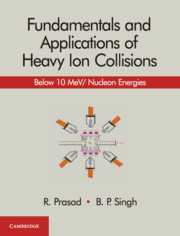1 - Introduction
Published online by Cambridge University Press: 20 October 2018
Summary
Background
Though the concept of the nucleus and the subsequent evolution of nuclear physics are credited to Rutherford, the earlier discovery of radioactivity by A. Henri Becquerel, Pierre and Marie Curie (1896–1898) played the most crucial role in these developments. The discovery of radioactivity opened up the way to new techniques of exploring subatomic systems – for example, by bombarding them with fast moving charged particles, a technique which is still in use, and used more vigorously now, even after hundred years.
In 1898, Pierre and Marie Curie succeeded in isolating significant amounts of two new elements from pitchblende, a uranium ore. They named the two elements polonium and radium. These new elements were found to undergo spontaneous self-destruction by emitting mysterious radiations. Passing of the collimated beam of these radiations through electric and magnetic fields revealed that they are made up of three components: negatively charged components, called beta particles; neutral components of electromagnetic waves of very short wavelength or gamma rays and a third component of positively charged particles. The negatively charged beta particles were identified as electrons, while the Curies established that the positively charged particles were doubly-ionized helium atoms, called alpha particles. The average kinetic energies of these alpha particles, beta particles and neutral gamma rays had different values for different radioactive sources. Radium and polonium, the two natural radioactive sources, emit alpha particles of energies in the range of 5 to 7 MeV. Rutherford, in his famous alpha scattering experiments, actually carried out by Geiger and Marsden, bombarded thin metallic foils by a collimated beam of alpha particles obtained from radium. In these experiments, it was observed that, on an average, one to five alpha particles out of about 20,000 particles, get scattered by more than 90°. Rutherford concluded that this is possible only if the target atoms have very small volumes at their centres where total positive charge and almost all mass of the atom are concentrated. Rutherford named this small volume as the nucleus of the atom, a term he borrowed from biological science. The layout of the experimental setup used by Rutherford is shown in Figure 1.1. The alpha particle source (radium) was kept in a lead box with a small hole to get the collimated beam.
- Type
- Chapter
- Information
- Fundamentals and Applications of Heavy Ion CollisionsBelow 10 MeV/ Nucleon Energies, pp. 1 - 35Publisher: Cambridge University PressPrint publication year: 2018



